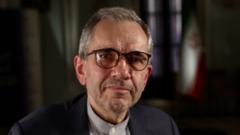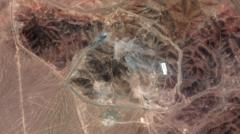Recent satellite imagery indicates the dismantling of migrant tents at Guantanamo Bay, prompting debate regarding the effectiveness and integrity of U.S. immigration policies under President Trump. Despite plans for housing thousands of migrants, only a fraction have been detained, raising concerns about resource use and due process.
Dismantling of Migrant Tents at Guantanamo Bay Raises Questions on U.S. Immigration Policy

Dismantling of Migrant Tents at Guantanamo Bay Raises Questions on U.S. Immigration Policy
Satellite images reveal the removal of migrant tents at Guantanamo Bay, leading to scrutiny over the Trump administration's detention plans.
The US military has recently dismantled a significant portion of the migrant housing camp at Guantanamo Bay Naval Base, as revealed by satellite images analyzed by BBC Verify. Initially, President Donald Trump initiated construction on this facility intending to accommodate 30,000 migrants soon after taking office in January 2017. However, the actual number of migrants housed has been notably lower.
As of mid-April, approximately two-thirds of the 260 tents designated for migrant housing have been removed, and a US defense official characterized this as a “deliberate and efficient use of resources” rather than a shift in operational readiness. In January, the Pentagon allocated around $38 million on detention operations at Guantanamo, highlighting the financial implications of this initiative.
The camp's construction commenced almost immediately following Trump's announcement, and visible activity continued for several weeks. This center was expected to serve a different purpose than the notorious military prison located at the same base, designed specifically for suspected terrorists. Recent images depict a significant reduction of military tents, suggesting a re-evaluation of the operation's scope.
Clarification on how many migrants are currently held at Guantanamo remains unclear. Amidst ongoing discussions, White House deputy chief of staff Stephen Miller maintained that Guantanamo is operational and continues to house a sizeable number of what he termed "foreign terrorist aliens.” Yet, in contrast to Trump's aggressive plans, the military's capacity estimates indicate the camps could only accommodate around 3,000 individuals.
Despite Trump's rhetoric on needing this expansion to detain individuals considered dangerous, the reality has proven that only about 400 migrants have been sent to Guantanamo, with more than half reportedly returned to the U.S. or deported, particularly to countries like Venezuela.
The operational costs associated with these actions have drawn harsh criticism. A recent visit from five Democratic senators resulted in allegations of wasteful expenditure and potential legal dilemmas regarding migrants' rights. They condemned the financial burden on taxpayers while highlighting the seeming lack of due process for those detained under this initiative.
This dismantling raises essential considerations regarding U.S. immigration policy, the effectiveness of measures aimed at controlling migration, and the ethical implications of utilizing military resources for such operations.





















